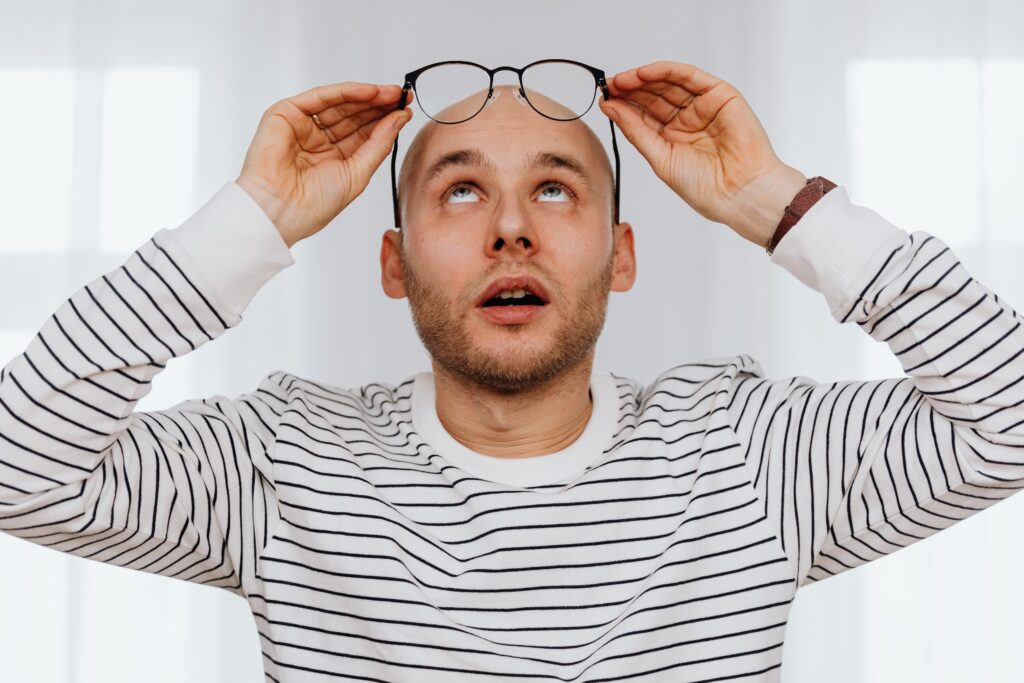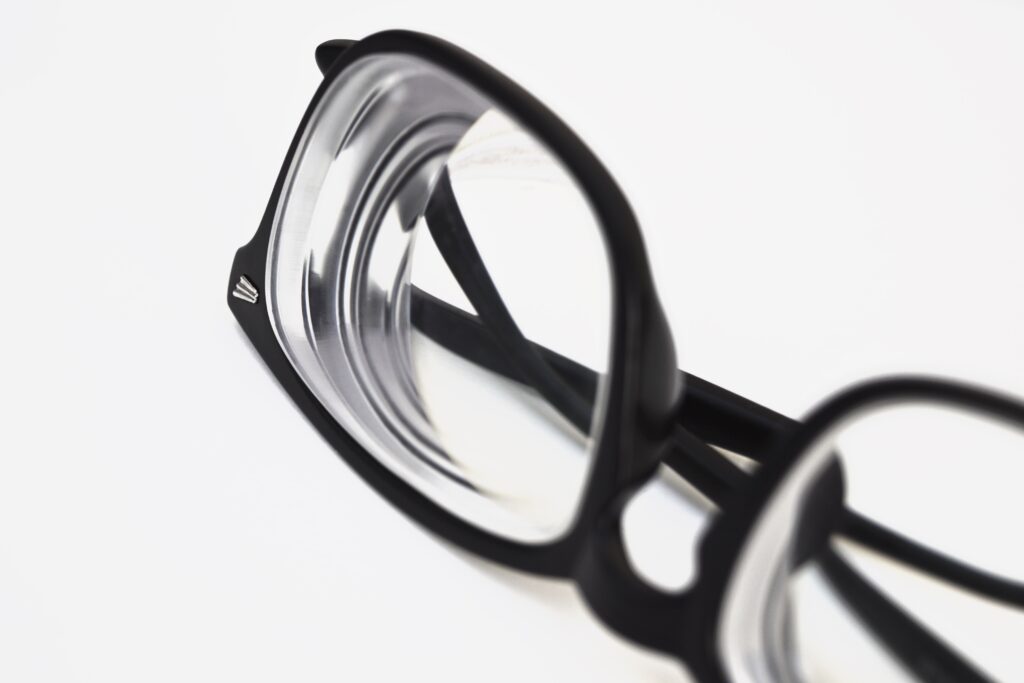What is your eyewear made of? A short guide to lens materials, their strengths, and weaknesses.

When purchasing eyewear, do you think about your choice of lens material?
Honestly?
Probably not (and that’s okay!)
While picking out eyeglasses, most of us seem to be more concerned with the type of lenses we are ordering (progressives, single vision, etc.) rather than stopping to think about what material they should be.
Yet, the lens material is one of the core factors in determining the success and functionality of eyewear.
If you want to know more about lens materials and how they affect your vision, we will cover it here. We also have recommendations for what wearers benefit from each one!
But before we dive in, we need to look at how
ABBE Value and Chromatic Aberration are interlinked and play a role in gaining the sharpest eyesight from your new glasses.
ABBE Value (also known as V value)
ABBE value (AV) is the value at which light disperses throughout the lens. The human eye itself has an ABBE value of around 45. The reason to know about ABBE value is that each lens material has a specific value, and your vision can be affected by the Abbe value of the lens material. Usually, the higher the ABBE number, the sharper the eyesight will be.
A lower ABBE number can result in our next term: chromatic aberration.
Chromatic Aberration
- Clear Vision
- Strong Chromatic Aberration
Chromatic aberration (or color fringing) is a visual distortion of light due to the inability of the white-light rays to disperse into their correct colors. This distortion results in a rainbow effect around viewed objects, causing an appearance of blurriness.
Now, just because a lens has a lower ABBE value, it does not mean that wearers will experience chromatic aberration. It is entirely dependent on each individual and how well their eyes and brain communicate with one another. Some wearers are more susceptible to chromatic aberration, while others may never notice it, even while wearing eyeglasses with a low ABBE value.
So what lenses have the best ABBE value and thereby the least risk of chromatic aberration? Let’s take a look at that as we uncover the strengths and weaknesses of different lens materials.
Plastic: AV 59
At 59, standard plastic lenses have one of the highest ABBE values. In addition to the clarity they offer, plastic lenses are one of the most cost-friendly options for eyewear, which keeps them in popularity.
However, they also have a downside. Plastic lenses are not impact-resistant and can shatter easily, so they are not ideal for wearers that are children or those with compromised vision (only vision in one eye). Since plastic is not a strong material and tends to crack easily, its weak tendency creates restrictions when selecting frames. Drill mount frames (no frame, just lenses) and rimless frames (half a frame around the lenses) are not recommended for plastic lenses because they might break easily. Its last offense is also noteworthy. Plastic lenses do not naturally have a scratch or UV protection, so adding scratch and non-glare coatings to these lenses is a MUST to get the full benefit of your eyewear. Without coverage for UV rays, you increase your risk for eye diseases like glaucoma, macular degeneration, and cataracts. Not only that, but without scratch resistance, your glasses will live a half-life.
Standard plastic material is best for: Those with mild prescriptions seeking to be economical and are unconcerned with the risk of a non-impact resistant material.
Polycarbonate: AV 30
AV 30
Polycarbonate (poly) has a lot of qualities that allow it to continue in popularity. Firstly, it is impact resistant – making it the top choice for safety eyewear. Children and those with compromised eyesight (vision in only one eye) NEED polycarbonate lenses to protect their eyes. Most doctors will even add it to the prescription to ensure patients receive poly lenses. Not only that, but eyesight protection is critical enough that most insurance companies will cover the cost of polycarbonate lenses for children and those with compromised vision. Secondly, poly is a thinner material than standard plastic and is beneficial for wearers with moderate prescriptions. Using poly allows wearers with moderately strong eyeglass prescriptions to enjoy the perks of thinner and lighter lenses without breaking the bank while also benefitting from an impact-resistant material.
Due to its durability, poly is widely used for rimless and drill mount frames as it does not crack easily, opening the door for a broader frame selection. Lastly, poly naturally has UV protection and blocks out nearly 100% of harmful UV rays.
So what is the downside to polycarbonate?
Well, first of all, poly has the LOWEST ABBE value of any available lens material. Yet, despite its low ABBE value, poly is still advantageous and continues to be used far and wide in the optical community.
Poly’s other flaw is that it is a soft material, even though it is impact-resistant. As a soft material, poly can scratch easily, so it is often highly recommended to have a scratch or anti-reflecting coating added to the lenses.
Poly is best for: People who need eye protection like, children or those with vision in only one eye, and those with moderate eye prescriptions.
Trivex:  AV 43-45
AV 43-45
Trivex is like the cute sibling of polycarbonate. Seriously, they share a LOT of the same features like UV protection, thinness, and impact resistance. However, Trivex offers crisper vision due to its higher ABBE value which is around 43-45. It is also the lightest weighing material available. Unsurprisingly, Trivex is quickly becoming a darling in the optical world. At 43-45, its ABBE value is closer to that of the natural human eye, and so it offers comfortable, clear vision to its wearers.
Trivex is beginning to gain more and more momentum in the optical community, but poly often is used in its place due to its affordability. Since Trivex costs more than poly, many opt for poly lenses in its place, though optically speaking, Trivex is by far the better choice regarding vision.
Trivex is best for: Those who want all the benefits of poly, with the lightest weighing material available, and who are not opposed to its slightly higher cost.
Hi-index:  AV 36
AV 36
There is not much bad to say about hi-index lenses. They are great for people with high prescriptions who would like their lenses to be thinner and lighter. They also have natural UV protection and a decent ABBE value.
The biggest downfall of hi-index is also its best benefit, namely its thinness. Because the lenses are so thin, light travels through the lenses more quickly, causing glare. As a result, hi-index lenses should always have a non-glare coating to keep the lenses from distorting vision. Hi-index material is also much more expensive than any of the other available materials. Opticians usually only recommend paying the premium for this material to those who would most benefit from it (usually those with a prescription over +/-5).
Hi-index lenses are best for those with markedly high prescriptions.
Glass: AV 39-59
Glass has one of the highest ABBE values and offers some of the clearest vision possible. It also has superior scratch resistance in comparison to other materials. Not only that, but it can also be incredibly thin, thinner than hi-index plastic lenses.
All of these factors make glass lenses seem ideal. Right?
Well, almost.
Glass material also comes with some hefty objections.
Primarily, glass lenses are H E A V Y.
Glass is the heaviest material available, so even the lowest prescription will feel substantial to the wearer. It is also fragile and carries the highest risk of chipping and shattering, so the natural fragility of glass increases the risk to eye safety.
Lastly, many of the modern technologies for eyeglass lenses are not available in glass materials. Because of the noted objections to glass, it is no longer the choice material in the optical community. As such, many manufacturers have not utilized it in the new lenses they create. The lack of glass availability is especially noticeable regarding progressive lenses, anti-reflective coatings, and quick-change transition lenses. These days, glass is used sparingly in the optical community. However, it is still limitedly available for those who want it.
Glass is best for those who: Have experience wearing glass lenses and are unconcerned with its limitations.
The next time you pick out new eyewear, be sure to reference this guide and remember to consult with your optician for any other questions you have about eyeglasses!



